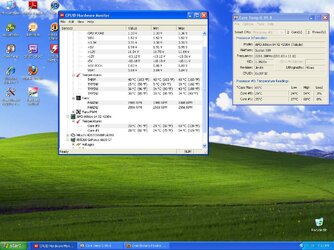- Joined
- Dec 14, 2010
Well, in an effort to lower the noise coming from my backup rig when I have to run it for one reason or another I set about installing an old Zalman CNPS7000 series heatsink I had here that I wasn't using for anything else.
I was hoping that this one would also run cooler at load, because it is larger, heavier, has a bigger fan, and is made entirely from copper, whereas the HSF it is replacing is made from mostly aluminum and has a smaller fan spinning at 5-7k rpm that is annoyingly loud even at it's lowest speed.
Results were not encouraging.
Stock heatsink load temps: 48-52°C, Zalman CNPS7000 load temps: 54-61°C max. Ouch...

Seems I'm still looking for a new HSF, and will have to find something else to do with this one. At least I do still have two or three other candidates here.
What remains are an Arctic Cooling Freezer Pro 64, a Zalman CNPS9500 LED, and either a Thermalright Ultima-90 or an Ultra 120 eXtreme (depending upon which one I feel like and whether or not I can find a way to fit the TRUE into my 775 rig (ran into fitment issues the last time I tried)).
I was hoping that this one would also run cooler at load, because it is larger, heavier, has a bigger fan, and is made entirely from copper, whereas the HSF it is replacing is made from mostly aluminum and has a smaller fan spinning at 5-7k rpm that is annoyingly loud even at it's lowest speed.
Results were not encouraging.
Stock heatsink load temps: 48-52°C, Zalman CNPS7000 load temps: 54-61°C max. Ouch...

Seems I'm still looking for a new HSF, and will have to find something else to do with this one. At least I do still have two or three other candidates here.
What remains are an Arctic Cooling Freezer Pro 64, a Zalman CNPS9500 LED, and either a Thermalright Ultima-90 or an Ultra 120 eXtreme (depending upon which one I feel like and whether or not I can find a way to fit the TRUE into my 775 rig (ran into fitment issues the last time I tried)).
Last edited: